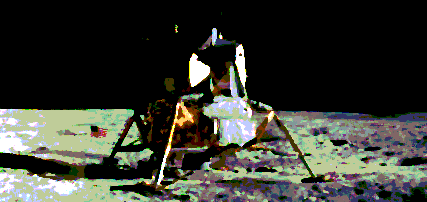
Apollo 14 (AS-509)
The Third Manned Lunar
Landing
 The Apollo 14 mission was the third manned lunar landing mission. Its objective was to perform detailed scientific lunar exploration.
The Apollo 14 mission was the third manned lunar landing mission. Its objective was to perform detailed scientific lunar exploration.
 The space vehicle with a crew of Alan B. Shepard, Jr., the commander; Stuart A. Roosa, the command module pilot; and Edgar D. Mitchell, the lunar module pilot, was launched from Kennedy Space Center, Fla., at 4:03:22 EST on January 31, 1971.
The touchdown occurred at 08:37:10 GMT, February 5, within 50m (160 ft) of the target point in the
Fra Mauro highlands. The first extravehicular activity (EVA) began 5 hr 23 min after touchdown.
A color television camera mounted on the descent stage provided live coverage of the descent of both astronauts to the lunar surface. The crew deployed the U.S. flag and and the solar-wind composition experiment, erected the S-band antenna, and off-loaded the
modularized equipment transporter (MET), laser ranging retroreflector (LRRR), and the Apollo lunar-surface experiments package (ALSEP).
The second EVA was a planned extended geological traverse of Cone Crater. All equipment required for the geological traverse, including the lunar portable magnetometer (LPM), was loaded on the MET. The traverse up the side of Cone Crater provided experience in climbing and working in hilly terrain in 1/6 earth gravity conditions. This EVA lasted 4 hr and 20 min, during which time the astronauts traveled approximately 3 km.
Liftoff occurred at 18:48 GMT, February 6, after 33 hr on the lunar surface. After crew transfer, the LM ascent stage was separated and remotely guided to impact on the lunar surface. Impact occurred between Apollo 12 and 14 seismometers. The resulting seismic signal lasted for 1.5 hr and was recorded by both instruments.
The command module splashed down in the Pacific Ocean approximately 1 km from the target point at 20:24 GMT, February 9, 1971.
The space vehicle with a crew of Alan B. Shepard, Jr., the commander; Stuart A. Roosa, the command module pilot; and Edgar D. Mitchell, the lunar module pilot, was launched from Kennedy Space Center, Fla., at 4:03:22 EST on January 31, 1971.
The touchdown occurred at 08:37:10 GMT, February 5, within 50m (160 ft) of the target point in the
Fra Mauro highlands. The first extravehicular activity (EVA) began 5 hr 23 min after touchdown.
A color television camera mounted on the descent stage provided live coverage of the descent of both astronauts to the lunar surface. The crew deployed the U.S. flag and and the solar-wind composition experiment, erected the S-band antenna, and off-loaded the
modularized equipment transporter (MET), laser ranging retroreflector (LRRR), and the Apollo lunar-surface experiments package (ALSEP).
The second EVA was a planned extended geological traverse of Cone Crater. All equipment required for the geological traverse, including the lunar portable magnetometer (LPM), was loaded on the MET. The traverse up the side of Cone Crater provided experience in climbing and working in hilly terrain in 1/6 earth gravity conditions. This EVA lasted 4 hr and 20 min, during which time the astronauts traveled approximately 3 km.
Liftoff occurred at 18:48 GMT, February 6, after 33 hr on the lunar surface. After crew transfer, the LM ascent stage was separated and remotely guided to impact on the lunar surface. Impact occurred between Apollo 12 and 14 seismometers. The resulting seismic signal lasted for 1.5 hr and was recorded by both instruments.
The command module splashed down in the Pacific Ocean approximately 1 km from the target point at 20:24 GMT, February 9, 1971.
From NASA SP-272, Apollo 14 Preliminary Science Report.
 Factoids
Factoids
-
- Lunar Module - Antares ; Command and Service Module - Kitty Hawk.
- Launched from Kennedy Space Center Launch Complex 39A.
- The Apollo 14 landing site is the same site selected for the aborted Apollo 13 mission.
- Second flight for Shepard: Mercury Redstone 3 (Freedom 7), first American in space on May 5, 1961; first flight for Roosa and Mitchell
- The crew remained in quarantine for 21 days from completion of the second EVA.
- Flags carried on this mission and returned to Earth included 25 United States flags, state and territories flags and flags of all the United Nations members, each four by six inches.
- The backup crew members were Eugene A. Cernan, commander; Ronald E. Evans, command module pilot; and Joe H. Engle, lunar module pilot.
- Mission Duration: 216 hr 1 min 58 sec.
Images from mission
Standard figures from Press Release package.
Michael J. Tuttle, June 16, 1995



 The space vehicle with a crew of Alan B. Shepard, Jr., the commander; Stuart A. Roosa, the command module pilot; and Edgar D. Mitchell, the lunar module pilot, was launched from Kennedy Space Center, Fla., at 4:03:22 EST on January 31, 1971.
The space vehicle with a crew of Alan B. Shepard, Jr., the commander; Stuart A. Roosa, the command module pilot; and Edgar D. Mitchell, the lunar module pilot, was launched from Kennedy Space Center, Fla., at 4:03:22 EST on January 31, 1971.

 Main Apollo page
Main Apollo page